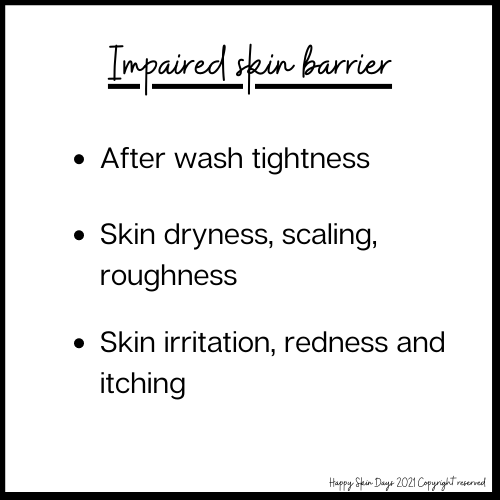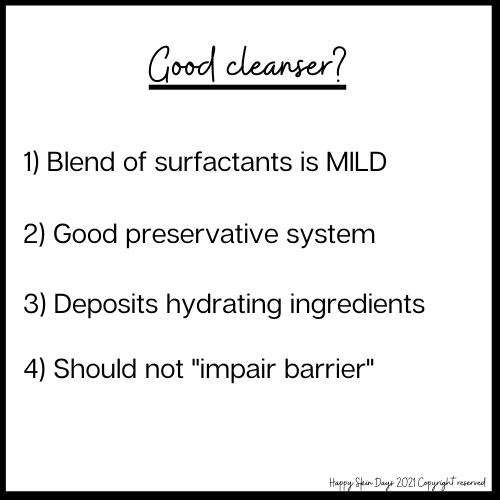In my previous blog, I have informed you that a poor facewash (contains strong surfactants) can impair your skin barrier causing all manner of problems:

In today’s blog, I want to explain what a good facewash should look like form my own experience and knowledge.
What do I mean by this?
Each of us have individual skin. So, what suits me may not so you. Because face washes are so important to maintaining a healthy skin barrier, if a new face wash causes my skin to become:
- tighter
- drier
- irritated or itchy
- inflammed
- reddish patches
then I will stop using that face wash. I don’t think to myself, I have spent $$$ on this face wash and therefore I must use it.
I have been burnt using bad face washes before and I know that it costs $$$$$$$ to repair the damage!!
..pH is a bit impractical
Also, I give little importance to pH of a facewash when I suggest products, because I can automatically assume two things about pH:
- It will be alkaline because most products contain Sodium or Potassium Hydroxide. This is a pH adjuster to make products more alkaline.
- The final pH of the facewash you use depends on the water coming out of your taps (and not the taps in my house). Just saying that I am not going to assess the pH of the thousands of my readers for each product I review…
…BEFORE we go on….its all about how you use your face wash…
I have observed how my cousins, aunts and other female who live in India wash their face and it really pains me to see them treat their facial skin as if it was a sack of potatoes.
After their daily commute OR just after a long day they do the following:
- use more facewash than necessary (you don’t need a WHOLE pump)
- fail to dilute the facewash enough before they put it on their face
- leave the facewash on their face for TOO long (more than 30 seconds)
- rub their face too hard with the face wash (increasing risk of barrier damage) and afterwards when they dry their face, there is no patting their face dry….
Even though surfactants may be mildly irritating (because they are sulfate based), HOW we wash our faces increases this irritation potential and increases the risk of barrier damage….
***
How to choose a good cleanser

1) Blend of surfactants is MILD
In the 30 products that I have reviewed, these are the most common surfactants (cleansing agents)
- Sodium Lauryl Ether Sulphate
- Cocamidopropyl Betaine
- Sodium Laureth Sulfate
Cocamidopropyl Betaine is a mild surfactant and its present because it reduces the irritation potential of the other sulphate based detergents.
Sodium Lauryl Ether Sulphate and Sodium Laureth Sulfate have great detergency action: that is, they are great at removing dirt and grim. But they are primarily used because they produce a lot of foam and are great for lather.
Asians like their facewashes and shampoos to have foam.
Non-foaming facewashes (such as Kama Ayurveda’s) are milder on your skin because they don’t have these two surfactants.
2) Good preservative system
Almost 90%+ of face washes in India rely on one of these preservative combinations:
- Methylchloroisothiazolinone and Methylisothiazolinone (see Should you avoid products with Methylisothiazolinone?)
- Parabens
- DMDM Hydantoin
- BHT
I can just about live with products that contain BHT, but really not the rest.
The problem with facewashes is that they contain a large percentage of water (and therefore are, very attractive to microbes). By necessity they must have a strong preservation system.
However, this is terrible news for your skin because strong preservative systems can damage the skin barrier.
My view is to avoid products containing any of the above preservatives. (Fun fact, in 2013, the American Contact Dermatitis Society named MI as contact allergen of the year).
I respect the fact that you may not feel so strongly about these preservatives….
3) Deposits hydrating ingredients
Again in over 90% of products, glycerin is present. You shouldn’t even think of buying a facewash that doesn’t contain glycerin because:
- Its an extremely cheap ingredient
- Topically applied glycerin increases the hydration levels in the stratum corneum. In English, it keeps the skin hydrated by reducing the amount of trans-epidermal water loss
- Its relatively easy to work with from a formulation perspective
See also The Critical Importance of Glycerin in the Skin
Baumman writes, “App et al compared 2 high glycerin moisturizers to 16 other popular moisturizers in 394 patients with severely dry skin. The high glycerin products were superior to all other products tested over this five year period because they rapidly restored dry skin to normal hydration levels. They also helped prevent the return to dryness for a long period than the other formulations, even those containing petroluatum.
Glycerin causes an expansion of the stratum corneum because of increased thickness of the corneocytes and expanded spaces between layers and corneocytes. These findings suggest that glycerin appears to create a reservoir of moisturing holding ability that renders the skin more resistant to drying.”
4) Should not impair the skin barrier
This last criteria is hard for me to assess unless I have used the facial cleanser for a period of time.
HAPPY SKIN DAYS. COPYRIGHT RESERVED 2021. I am a non-affiliated skincare blogger. I invest my own resources in researching and creating content for my blog. The contents of this blog, including images are protected by copyright law(s). My content cannot be replicated without my consent. You can write to me at email@happyskindays.com. I will file criminal and civil charges for copyright infringement.